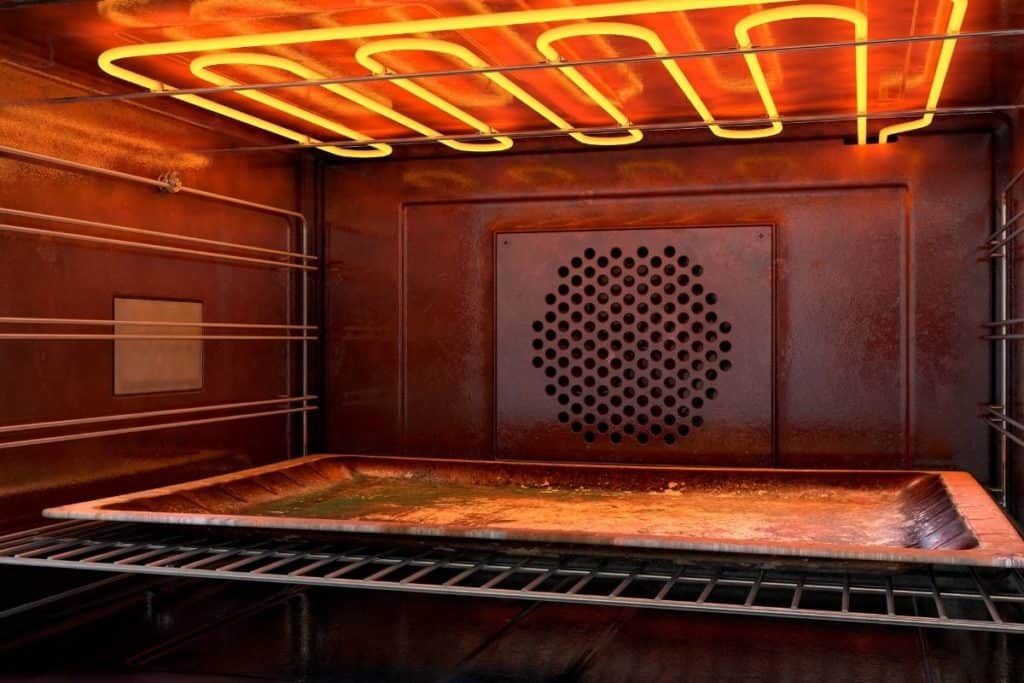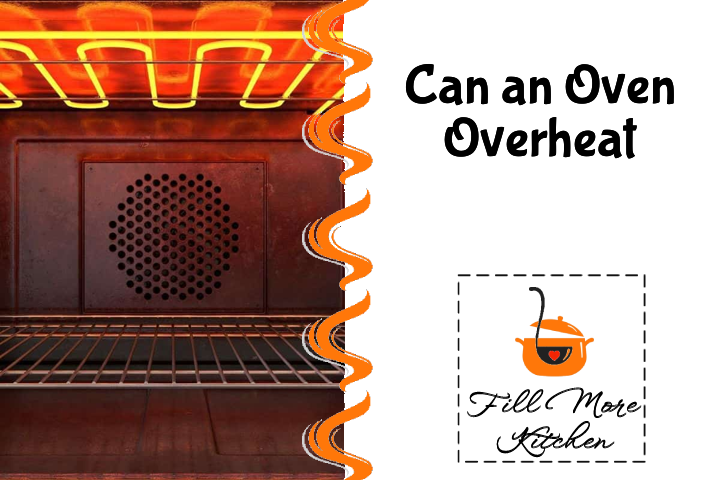Despite the importance of the information, I am asked this question less frequently than expected: Can an Oven Overheat? Ovens have been a household staple for a long time.
Due to our familiarity with the oven, we may feel secure around it as we are aware of its functioning, purpose, and have prior experience using it.
However, when the components of the oven begin to malfunction, you will have a completely different appliance that is difficult to manage, unpredictable, and unsafe. Additionally, an overheating oven has the potential to burn almost all of the dishes it prepares.
Yes, an oven can overheat due to various reasons such as a malfunctioning thermostat, temperature sensor, cooling fan or heating element. Typically, the issue arises from a defective thermostat that fails to regulate the temperature; however, it can also be caused by a heating element generating excessive heat or a non-functional cooling fan.
Despite the advanced technology in modern high-end kitchen appliances, they can still malfunction and overheat, even with automatic adjustments made by sensors to parameters such as temperature, reducing the need for constant monitoring.
Examining the reasons behind an oven‘s potential overheating and determining appropriate actions to take is necessary.
What Causes an Oven to Overheat?
Electric ovens have an average lifespan of 13 years, while gas ovens can last up to 15 years, and within this period, they are utilized numerous times, varying from one household to another.
Although we hope to avoid the need for oven maintenance, repair, or replacement, overheating can be a common issue that some of us may face. As such, it is crucial to comprehend the potential causes of this problem.
- Faulty Thermostat: The thermostat is responsible for monitoring the internal temperature of the oven and making necessary adjustments to maintain a consistent temperature, by turning the heating element on or off as needed. If the thermostat is faulty, it will not be able to accurately read temperatures, leading to a breakdown in communication between it and the heating element.
- Cooling Fan: If the cooling fan is not functioning properly, it can lead to uneven heating in the oven, resulting in burnt or overcooked food in some areas.
- Heating Element: The heating component reacts to the signals sent by the thermostat and adjusts the temperature as required to either sustain, decrease, or raise it. In case the heating element fails to receive a signal indicating that the desired temperature has been achieved, it will keep on heating the oven, leading to overheating.
- Temperature Sensor: The temperature sensors are responsible for detecting the oven’s temperature and assisting in regulating it, so if they malfunction, the oven may experience overheating or underheating.
- Thermostat Knob: In case the thermostat knob is not securely mounted, the temperature indicated by the numbers on it may not accurately reflect the true temperature of the oven.
- Oven Ventilation: In case the oven’s airflow is obstructed, it may struggle to circulate air, leading to overheating. It is advisable to inspect if there is anything that could be impeding the proper functioning of the oven’s ventilation system.
- Selector Switch: The selector switch serves as a mediator between the thermostat and the heating element, and if it malfunctions, it can disrupt communication between the two components, resulting in the heating element continuing to heat even when the oven has reached its desired temperature.
- Control Panel: While not all models have a control panel, some do, and it is a fragile component that can malfunction due to a minor power outage. It is advisable to have someone experienced check the control panel, and contacting customer service is recommended.
- Buildup of dirt and grease: As time passes, the thermostat may accumulate dirt and grease, leading to malfunction. To resolve this problem, removing and cleaning the thermostat should be sufficient.
If your oven is overheating, it’s important to troubleshoot the issue before attempting any repairs. It’s highly recommended that you reach out to customer service for guidance and information before taking matters into your own hands.
Breaking the seal of a new device can result in the warranty becoming invalid.
How Do You Know If Your Oven is Overheating?

After burning three batches of cookies, I realized that my oven might be overheating, which could also be due to my inability to multitask and remember things.
Irrespective of the circumstances, determining whether your oven is overheating or not can be done much more easily by just checking its temperature.
Here’s what you do.
- Adjust the oven temperature to 350 degrees Fahrenheit
- Put an oven-proof thermometer on the middle rack of the oven
- To ensure safety, it is recommended to wait for 15-20 minutes until the oven has completed preheating, and waiting for an additional 5 minutes would be even safer.
- Verify if the thermostat readings correspond to the temperature you have programmed on the oven, and if they do, then your oven is functioning correctly.
- When the temperature of your oven exceeds the set temperature, it is a clear indication that your oven is overheating.
Keep in mind that if your oven displays a temperature of 351 degrees when you set it to 350, it is not overheating; this is simply a normal occurrence.
How Do I Fix an Overheating Oven?
Now that you have identified that your oven is overheating, the next step is to figure out what actions to take. It’s not enough to just recognize the issue; you need to know how to address it.
As we discussed earlier in the article, there are various reasons for an oven to overheat. Consequently, there are also multiple solutions available. However, depending on the root cause of the problem, it may be necessary to seek assistance from a certified repair technician as some issues can be complex.
Replacing or Fixing the Thermostat
Replacing the thermostat can solve the issue, and these are readily available in stores and online; it is recommended to check with the oven manufacturer if they sell thermostats separately.
The process of replacing the thermostat may vary depending on the model, but a general idea can be obtained from this guide.
It should be noted that a malfunctioning thermostat may not always require replacement, as it could potentially be repaired with minimal effort depending on the issue at hand.
Thermostat often accumulates grease, which can compromise its ability to sense temperature. Cleaning the thermostat is a simple task that can solve the problem.
If your oven is overheating, try cleaning the thermostat, and if that doesn’t work, think about replacing it.
Replace or Fix the Oven’s Fan
If you are certain that the cooling fan is causing the issue, it can be replaced similar to the thermostat, and doing so should result in the oven’s temperatures stabilizing as desired.
If a fan in an oven is broken, it can cause overheating because the heat produced inside the oven is not evenly distributed throughout the cavity, leading to the formation of hot spots where hot air accumulates instead of circulating.
If the cooling fan is not functioning, it is recommended not to use the oven as it can easily overheat and pose a potential danger. Therefore, it is advisable to refrain from using the oven until the issue has been resolved to prevent any harm.
When checking for a malfunctioning fan in your oven, pay attention to any unusual sounds it may be making, as well as its inability to properly circulate heat, as these are two clear indications of a problem.
To ensure that the blade is not obstructed, manually rotate it with your hands by unplugging the oven, opening the door, and grasping the fan’s blades to turn them either clockwise or counterclockwise to determine if they can move freely.
If the blades are not spinning or are spinning with difficulty, it is recommended to clean the oven’s fan thoroughly as it tends to accumulate grease and dirt over time, which can impede its proper functioning.
If the blades of the oven fan seem rigid, it could indicate a faulty motor.
Anticipate spending between $100 and $275 for a replacement fan if you have to cover the repair costs yourself.
Replacing or Fixing The Heating Element
The heating elements of the oven, also referred to as “coils”, are typically located at the top and bottom of the oven’s interior and are responsible for generating heat in the oven; you may have seen or inadvertently touched them while reaching for your food.
When an oven’s heating element is not functioning properly, a technician will initially conduct a visual examination of the element to determine if it has been damaged or become loose; while apparent indications of damage or looseness are straightforward signs of a malfunctioning element, there may be instances where the damage is concealed within the outer casing.
It is not always the case that a heating element will stop producing heat completely when it malfunctions; instead, it may produce excessive heat which can lead to oven overheat.
Once you have visually examined the heating element, utilize a multimeter to check various sections of it for any irregularities. If any of these evaluations are unsuccessful, then substitute the heating element.
The cost of replacing an oven’s heating element varies between 60 to 150 dollars, depending on the model.
How Do I Prevent an Oven from Overheating?
Monitoring the oven’s behavior to detect irregularities in its effectiveness is crucial in preventing it from overheating, but many of us may struggle with this task due to a lack of awareness or consideration of the potential risk.
It can be challenging for the average user to monitor the duration required for the oven to reach the desired temperature and subsequently cool down, but it can prove beneficial in the long run.
While it’s not necessary to worry excessively, it’s advisable to periodically check if the oven is functioning as expected by observing if it takes longer or shorter than usual to reach the desired temperature, experiences difficulty in cooling down, and displays a temperature reading that doesn’t correspond with the knob setting.
If you observe any problem with your oven, it is advisable to contact a professional immediately rather than waiting for a complete breakdown.
Can Ovens Explode?
When we hear the word “explosion,” we may imagine a severe incident, but it is unlikely to occur in an oven. Although there are some documented cases, they are rare and usually involve external factors.
Despite being reported by many users, the explosion of glass doors in ovens should not be considered a sign of inferior quality as it has occurred with most brands.
Tempered glass, which is heated to high temperatures and then rapidly cooled down to increase its strength against high heat, is used in glass oven doors.
While an oven’s glass door shattering is not caused by overheating, there are some measures you can take to reduce the chances of it breaking.
- Caution should be exercised while placing pots, dishes, and trays on an exposed glass door.
- Exercise caution while cleaning the glass by avoiding excessive force and using appropriate cleaning products.
- Avoid subjecting the glass to sudden and extreme changes in temperature as it can lead to the glass breaking or becoming significantly weaker, such as placing a dish that is ice-cold on a hot glass door.
- To prevent the oven door from hitting the racks, ensure that they are properly positioned before closing the door.
You can also check this video about “Can an Oven Overheat? (Yes, so here’s what to do)”
Check out our 10 reviews!
Related posts
https://fillmorekitchen.com/do-electric-grills-produce-smoke/
https://fillmorekitchen.com/how-long-does-cooked-shrimp-last-in-the-fridge/
https://fillmorekitchen.com/can-you-add-cold-oil-to-hot-oil-when-frying/
https://fillmorekitchen.com/can-you-eat-soft-boiled-eggs-left-out-overnight/
https://fillmorekitchen.com/first-things-to-check-when-a-refrigerator-stops-working/



